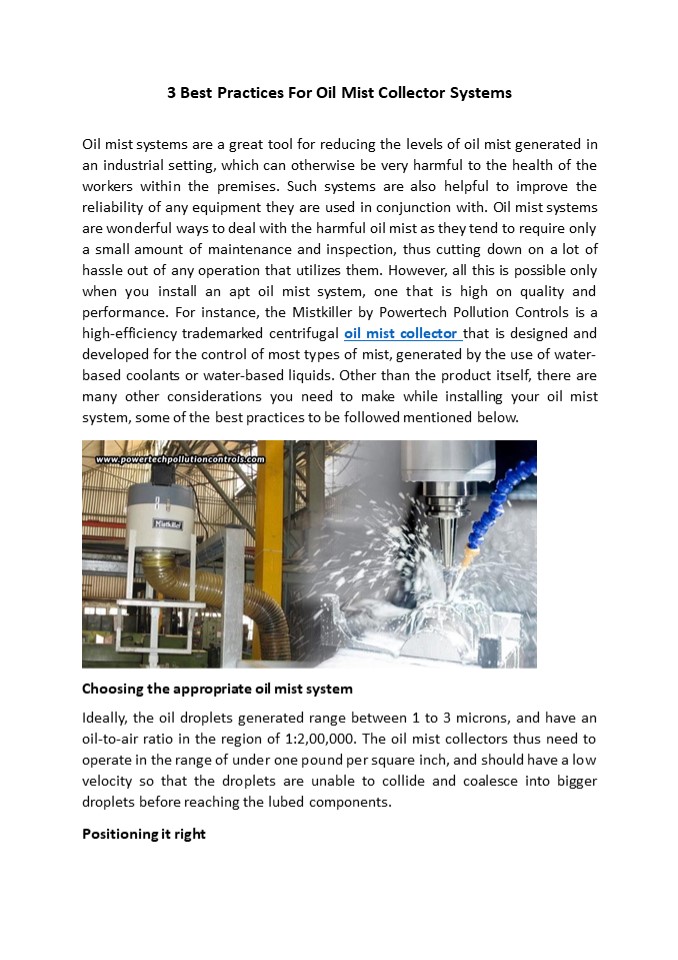3 Best Practices For Oil Mist Collector Systems - PowerPoint PPT Presentation
Title:
3 Best Practices For Oil Mist Collector Systems
Description:
As much as it is important to choose the appropriate oil mist collector, it is also vital to follow these 3 best practices for your oil mist collector system, to ensure that you have a safe working environment. – PowerPoint PPT presentation
Number of Views:0
Title: 3 Best Practices For Oil Mist Collector Systems
1
3 Best Practices For Oil Mist Collector
Systems Oil mist systems are a great tool for
reducing the levels of oil mist generated in an
industrial setting, which can otherwise be very
harmful to the health of the workers within the
premises. Such systems are also helpful to
improve the reliability of any equipment they
are used in conjunction with. Oil mist systems
are wonderful ways to deal with the harmful oil
mist as they tend to require only a small amount
of maintenance and inspection, thus cutting down
on a lot of hassle out of any operation that
utilizes them. However, all this is possible only
when you install an apt oil mist system, one
that is high on quality and performance. For
instance, the Mistkiller by Powertech Pollution
Controls is a high-efficiency trademarked
centrifugal oil mist collector that is designed
and developed for the control of most types of
mist, generated by the use of water- based
coolants or water-based liquids. Other than the
product itself, there are many other
considerations you need to make while installing
your oil mist system, some of the best practices
to be followed mentioned below.
Choosing the appropriate oil mist system Ideally,
the oil droplets generated range between 1 to 3
microns, and have an oil-to-air ratio in the
region of 12,00,000. The oil mist collectors
thus need to operate in the range of under one
pound per square inch, and should have a low
velocity so that the droplets are unable to
collide and coalesce into bigger droplets before
reaching the lubed components. Positioning it
right
2
For an oil mist system to work correctly, it must
be placed roughly within 600 feet of the process
pumps. Also, the primary 50 feet of supply piping
needs to be slanted back towards the generator,
so that any excess oil will find its way back to
the pump, thus decreasing the amount of oil
wastage. And, the remaining piping should be
either sloped back towards the mist generator or
any low areas with a drain port, so that oil can
be trapped. Regular inspection Choosing the right
oil mist collector and positioning it right are
only the first steps. Once everything is up and
running, you shouldnt consider everything done.
Instead, youll need to ascertain that regular
inspection and checks are done to ensure that
everything continues to function at its optimum
capacity. Some of the main elements to check for
regularly and thoroughly include the air filter,
regulator, separator, air heater, oil reservoir,
and the fittings. It is a good idea to get a
qualified professionals, with enough experience
in dealing with oil mist systems, to perform the
regular checks and inspections. And, in between
such professional checks, it is also vital that
you, on your part, regularly check the air
filters and air separators, and make sure they
are kept clean at all times, so that regular
clean supply of air can be pumped. With the right
oil mist collector installed, and the above best
practices followed, you should be good to
go! Visit our website https//www.powertechpollut
ioncontrols.com/































